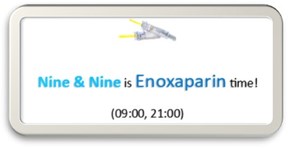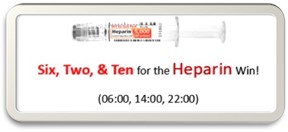Venous Thromboembolism Prophylaxis
Original Date: 07/2025
Recommendations for VTE Prophylaxis:
- For trauma patients, provide low-molecular weight heparin (LMWH) or unfractionated heparin (UH) and mechanical prophylaxis, preferably with intermittent pneumatic compression (IPC), unless contraindicated.
- For major trauma patients in whom LMWH and UH are contraindicated, mechanical prophylaxis, preferably with IPC, over no prophylaxis when not contraindicated by lower-extremity injury. Adding pharmacologic prophylaxis with either LMWH or UH when the risk of bleeding diminishes or the contraindication to heparin resolves.
VTE Prophylaxis Drug Dosing:
| Enoxaparin | ||
| Patient Weight | Renal Function | Drug Dosing |
| < 45 kg | Crcl > 30 mL/min | enoxaparin 20 mg subcutaneous q12 hours |
| 45-89 kg | enoxaparin 30 mg subcutaneous q12 hours | |
| 90-129 kg | enoxaparin 40 mg subcutaneous q12 hours | |
| ≥ 130 kg | enoxaparin 50 mg subcutaneous q12 hours | |
| Unfractionated Heparin | ||
| Patient Weight | Renal Function | Drug Dosing |
| < 90 kg | Crcl < 30 mL/min | heparin 5,000 mg subcutaneous q8 hours |
| ≥ 90 kg | heparin 7,500 mg subcutaneous q8 hours | |
Timing of VTE Chemoprophylaxis:
- Dosing Schedule
- Enoxaparin: administer at 0900 and 2100 schedule
- Heparin: administer at 0600, 1400, and 2200 schedule


- To avoid missed doses, initiate VTE prophylaxis at the earliest time based on the above schedule.
- Example: Patient arrives in trauma bat at 0600 – start enoxaparin at 0900 after excluding traumatic brain or spine injury requiring emergency operative intervention.
Contraindications to the Immediate Initiation of VTE Chemoprophylaxis:
- Solid organ injury:
- Non-operative management of spleen, liver, and kidney injuries (ALL grades)
- Start VTE prophylaxis within 24 hours of hospital arrival, using the above administration schedule (at the first 0900/2100 following exclusion of TBI or spine injury requiring emergency operation)
- Patient may still be in emergency department at time of prophylaxis administration.
- If a patient undergoes angiography or operative repair of a solid organ injury, that injury is considered resolved and VTE chemoprophylaxis can begin immediately if:
- The angiography shows no extravasation/pseudoaneurysm
- The extravasation/pseudoanuerysm is successfully embolized
- The bleeding is controlled surgically
- VTE chemoprophylaxis should be held for patients with bleeding controlled by temporary measures (e.g. surgical packing) until transfusion requirements abate and coagulopathy resolves (ideally, within 24 hours)
- Non-operative management of spleen, liver, and kidney injuries (ALL grades)
- Traumatic brain injury:
- VTE prophylaxis to begin 24 hours after admission (BIG 1 and 2 patients)
- VTE prophylaxis to begin 24 hours after stable CT Head (BIG 2 and 3 patients)
- VTE prophylaxis to begin 24 hours after craniotomy
- Chemoprophylaxis does not need to be held for EVD or ICP placement or removal.
- Spine fractures and spinal cord injuries:
- Final spine disposition should occur within 6 hours from consult
- Will include operative versus non-operative plan and time of operation
- Non-operative spine injury patients
- Begin VTE prophylaxis unless other contradiction present
- If epidural/subdural hematoma present on MRI, begin VTE chemoprophylaxis 24 hours after admission
- Operative spine injury patients
- Only hold the dose that would be given in the operating room.
- After discharge, spinal cord injury patients or spine fractures patients that are immobile should continue VTE chemoprophylaxis with 81 mg aspirin BID for 12 weeks post operatively.
- Exceptions to this protocol will exist and should be communicated between attending physicians.
- Final spine disposition should occur within 6 hours from consult
- VTE chemoprophylaxis in trauma patients is NOT routinely held in the following circumstances:
- Interventional radiology procedures
- Orthopedic operations (except spine cases)
- Any other operating room case not discussed above.